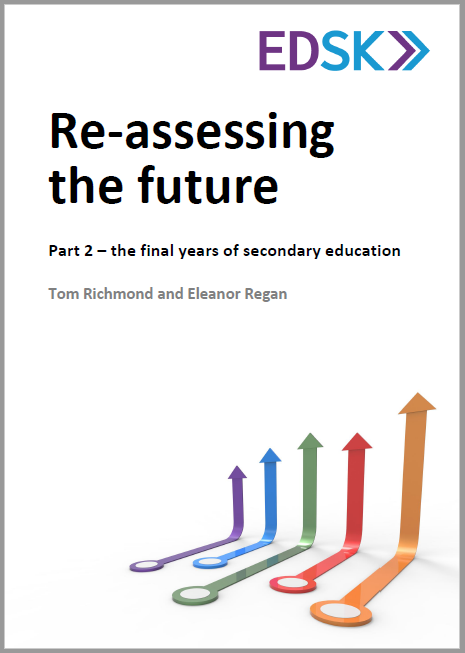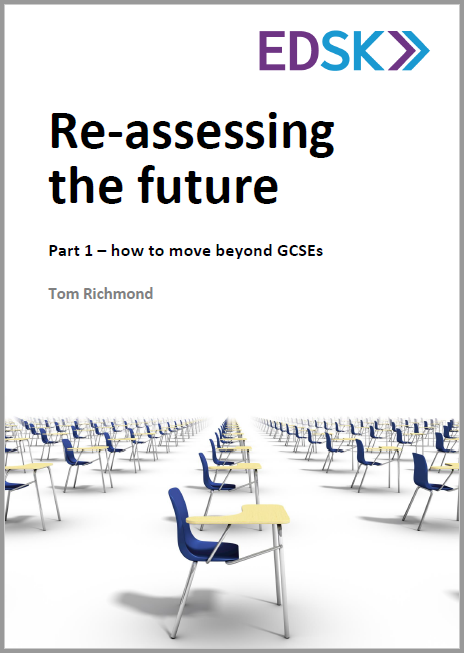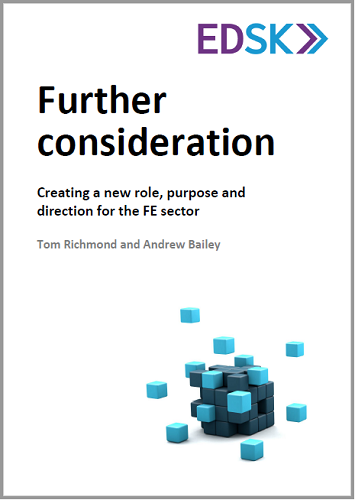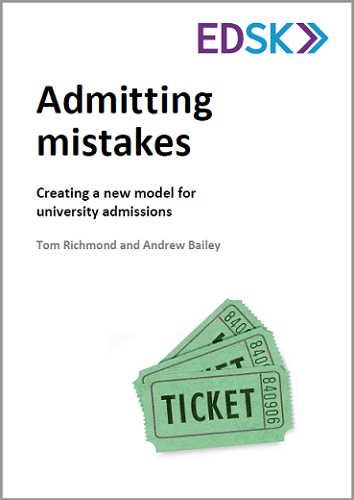This page contains a list of all the reports, articles and other publications that I have contributed to over the years. They are accompanied by a short description, and you can download the full publication by clicking on the front cover images.
RE-ASSESSING THE FUTURE (PART 2)
APRIL 2021
The dominance of A-levels in the final years of secondary education is inescapable. Of the 328,000 students who finished studying in 2020, 83 per cent of them had studied at least one A-level. Countless other qualifications have come and gone since A-levels were created 70 years ago, but it would be wrong to assume that just because a qualification has been successful in the past that there is no reason to discuss its future.
This new report is the second of two publications from EDSK that aim to plot a new course for state-funded secondary education in England. In January 2021, EDSK published a major report calling for GCSEs to be replaced by online assessments over the next few years because these exams have remained largely untouched since 1988, yet the education system around them has changed dramatically in that time (see ‘Part 1’ below). A high-stakes and hugely expensive set of school-leaving qualifications for 16-year-olds no longer makes sense when young people are required to remain in education or training until age 18. It is therefore important to ask whether A-levels still deserve their cherished status within secondary education, and what implications the dominance of A-levels has for other qualifications available to young people in their last years at school or college.
RE-ASSESSING THE FUTURE (PART 1)
JANUARY 2021
The impact of COVID-19 on school examinations in 2020 and 2021 has been devastating, yet it would be wrong to assume that all was well before the coronavirus took hold. Examinations at the age of 16 – historically, the school leaving age – have been a central feature of secondary education in England for decades. First came O-levels in 1951 (accompanied by CSEs from the early 1960s), followed by GCSEs in 1988. Although the role of GCSEs as a school-leaving qualification has essentially remained unchanged, the raising of the ‘participation age’ from 16 to 18 has prompted serious questions about whether academic-style examinations for all students at age 16 are still fit-for-purpose. In addition, critics of GCSEs complain about the burdens they place on pupils and teachers, their distorting effect on the curriculum and the punitive effects of the accountability system that accompanies GCSEs. The extraordinary events of the last year have also highlighted the fragility of any assessment system that relies so heavily on high-stakes terminal exams.
In contrast, supporters of GCSE frequently draw attention to their emphasis on a ‘broad and balanced’ range of subjects, their rigorous curricula and their function as a valid and recognised currency among different stakeholders. The challenge, then, is to redesign the assessment and accountability system so that it carries forward the strengths of GCSEs while addressing the concerns noted above. This report is the first of two publications from EDSK that aim to plot a new course for state-funded secondary education in England. Both reports start from the premise that for any set of reforms to succeed, they must deliver the following four objectives for secondary education as a whole:
- RIGOUR: all qualifications and training routes available in secondary schools and colleges must represent a high-quality programme of learning that prepares young people for the next stage in their educational journey.
- COHERENCE: the system of qualifications and associated assessments must be easy to understand and easy to navigate because it is based on a single coherent narrative and a single set of terminology.
- VALUE: all the programmes on offer to young people must be valued by all stakeholders, even if they serve different purposes for different learners.
- ASPIRATION: the secondary education system must encourage young people to progress in their learning and be aspirational about what they can achieve.
FURTHER CONSIDERATION
SEPTEMBER 2020
After spending years, perhaps decades, in the policy shadows, the Further Education (FE) sector in England is finally attracting the attention of policymakers. Last year, the ‘Augar Review’ of post-18 education declared that FE colleges “are an essential part of the national educational infrastructure and should play a core role in the delivery of higher technical and intermediate level training.” The Conservative Party election manifesto in 2019 subsequently promised significant investment in FE colleges (FECs). More recently, Education Secretary Gavin Williamson stated that “further education is central to our mission of levelling up the nation”, adding that colleges are “the beating hearts of so many of our towns.” He also set out the government’s desire to bring about “a wholesale rebalancing towards further and technical education” based on “a comprehensive plan to change the fundamentals of England’s further education landscape, inspired by the best models from around the world.”
These commitments are welcome and important. The question now is how they will be delivered in practice. This report outlines a package of reforms that aims to ensure the FE sector is:
- Respected: stakeholders from across the education system, from schools up to universities, as well as the general public should recognise and cherish the value of FE to them and to society as a whole.
- Ambitious: high-quality teaching and learning and clear progression pathways should be central to what FE offers learners at a local and national level.
- Responsive: learners and employers should be confident that the FE sector is willing to listen to, and respond to, their needs and interests.
- Stable: colleges deserve to operate in an environment that provides certainty and security, both politically and financially.
ADMITTING MISTAKES
JUNE 2020
Since UCAS was created in 1993, it has administered a system of competitive applications from students in which universities choose whom to admit. Students must submit various types of information including their predicted exam grades, a ‘personal statement’ and academic references, after which universities assess the information provided by candidates and decide whether to offer them a place. This admissions system has remained almost unchanged for the past three decades, but this inertia should not necessarily be interpreted as an indication that the UCAS system is working well.
This report starts from the widely accepted premise that HE admissions must be:
- Fair – every student, irrespective of their income or wealth, should have access to the same universities and degree courses;
- Transparent – every student should have access to the information they need to make informed choices about the different options available to them;
- Equitable – every student, regardless of their background, should be able to compete for a place at university on a ‘level playing field’ with other students.
The report analyses the three issues that have attracted the most attention in terms of their respective impact on the fairness, transparency and equity of the admissions system: the use of predicted grades for university applications; the growth of ‘unconditional offers’ from universities; and the barriers facing disadvantaged applicants.
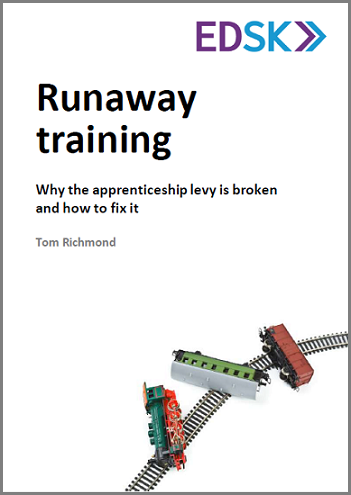
RUNAWAY TRAINING
JANUARY 2020
The apprenticeship levy began operating in April 2017. The levy is, in effect, a tax of 0.5 per cent on the pay bill of UK employers with annual wages of over £3 million. These employers pay their levy contributions into a digital account held by HMRC and can then ‘spend’ their contributions on apprenticeships delivered by registered training providers. Other employers who do not pay the levy can access the funds that the levy generates through arranging apprenticeships with registered providers as well. In its first full year of operation, the levy raised £2.7 billion and this is expected to rise to £3.4 billion by 2023-24. However, there have been repeated warnings in recent months that the funding pot generated by the levy is about to run out. This report investigates what is happening with the apprenticeship levy and with the apprenticeship system in England more broadly.
The swift disappearance of the funds raised by the levy is the direct result of the dilution of the apprenticeship brand caused by the rapid emergence of ‘fake apprenticeships’. Regrettably, it has reached the point where the apprenticeship brand itself has arguably become a meaningless concept, such is the prevalence of the inappropriate rebadging and relabelling of existing training courses by some employers and universities. Given the looming prospect of a significant overspend on apprenticeships in the coming months, there is no doubt that the Treasury and the Department for Education must enact major changes to make the apprenticeships programme financially viable. The only question now is what changes they will choose to make.
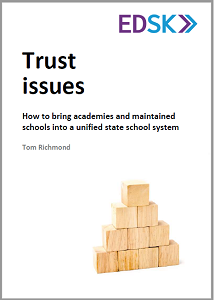
TRUST ISSUES
SEPTEMBER 2019
It would have been hard to imagine back in 2002 when the first ‘city academy’ opened that such a small, targeted scheme aimed at replacing failing schools in urban areas would end up becoming one of the most contentious educational debates in living memory. The situation we are left with almost two decades later is complicated, to say the least. Approximately one-third of primary schools and three-quarters of secondary schools now operate as ‘academies’ i.e. state schools that are outside of local authority control. In effect, England now has two sets of state schools which are run separately from one another – local authority (‘maintained’) schools and academies. Inevitably, this has produced a fragmented and incoherent education system, with little sign of improvement on either front. What’s more, neither maintained schools or academies appear to be out-performing the other, yet considerable energy is being expended by politicians and civil servants to maintain the distinction between these two systems.
This report starts from the simple premise that it is better to have one system for state schools in England rather than two, so that all stakeholders – pupils, parents, teachers, school leaders, local communities and politicians – can judge schools on a ‘level playing field’ where every school is given the same support and opportunities to succeed. This report proposes that, instead of aiming for either a fully ‘maintained’ or fully ‘academised’ system, it is best to work with the existing landscape to build a unified system in which multiple types of schools and school groupings can flourish.
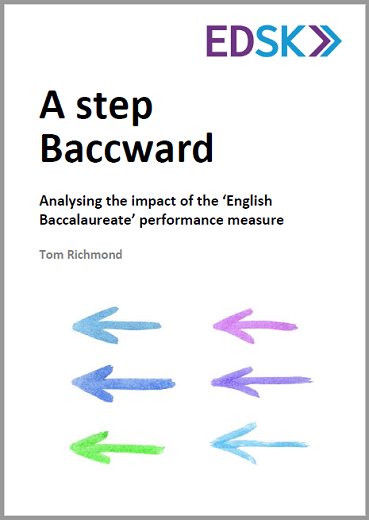
A STEP BACCWARD
JULY 2019
Despite its confusing name, the EBacc is a ‘performance measure’ for schools that records the percentage of pupils who enter and pass their GCSEs in all the following subjects:
- English language and English literature;
- Mathematics;
- Either history or geography;
- A language (modern or ancient); and
- At least two of the three single sciences (biology, chemistry, computer science and physics) or ‘Combined Science’
Supporters of the EBacc claim that it promotes the study of a broad range of GCSE subjects and that it is needed to prevent schools offering less challenging subjects to their pupils, particularly those from disadvantaged backgrounds. Improving the academic prospects of poorer pupils would, in turn, support greater social mobility. Meanwhile, the EBacc’s detractors claim that it has harmed subjects that are not included in the EBacc, leading to a narrow curriculum in many schools as well as the demise of important subjects.
This new report analyses what has happened since the EBacc first appeared in terms of GCSE subject entries and outcomes as well as the extent to which any observed changes can be reasonably attributed to the EBacc itself.

FREE TO CHOOSE
MAY 2019
Our post-18 education system is broken. The total value of outstanding student debt has already passed £100 billion and is forecast to reach around £450 billion by the middle of this century. With the vast majority of universities charging £9,250 per year for undergraduate degrees, students are typically finishing their courses with £40,000-£50,000 of debt. Worse still, almost one-third of graduates are now in non-graduate jobs and can find themselves earning less than if they hadn’t attended university at all. Not only is the plight of graduates creating significant political and financial problems, colleges and apprenticeships remain under-funded and under-utilised after successive governments have chosen to emphasise the supposed benefits of attending university at the expense of other options available to learners of all ages. Hence, from multiple perspectives – long-term viability, financial sustainability, educational equity and social mobility – the current system is failing to deliver consistently positive outcomes for students, taxpayers and employers.
Inevitably, the political sensitivity of university tuition fees has meant that it continues to dominate media coverage of the ‘Augar Review’. However, in her speech that launched the review, it was striking how often the Prime Minister referred to ‘tertiary education’ and she was clear that the review will look at “the whole post-18 education sector in the round, breaking down false boundaries between further and higher education, to create a system which is truly joined up.” Consequently, this report seeks to deliver the Prime Minister’s ambition by creating a single funding system to underpin a single tertiary education system in which universities, colleges and apprenticeships can all thrive. To this end, instead of focusing on how much the government should invest in tertiary education, this report focuses on how the government should invest. If the objective is to reduce spending on tertiary education while meeting the Prime Minister’s four goals for the Augar Review, students will have to start making different choices about what they study, where they study and how they study after age 18. The simplest and most effective way to achieve this is to put the funding for tertiary education in the hands of the students themselves.
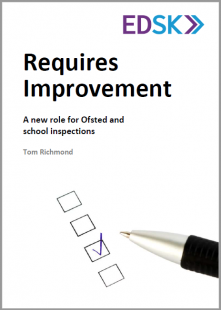
REQUIRES IMPROVEMENT
APRIL 2019
Despite their desire to be seen as a ‘force for improvement’, Ofsted’s own survey showed that just 24% of teachers agree that they perform this function. This report describes how Ofsted’s approach to judging teachers and schools is not based on research evidence from this country or abroad, nor have the reliability and validity of their judgements ever been satisfactorily tested and assured. While these issues could be tackled in isolation, the widespread effects of Ofsted’s approach to inspecting schools show that merely modifying existing processes and procedures will not be sufficient to bring about the changes that are now required.
There is still a crucial place in our education system for an independent inspectorate that visits schools to provide parents of current and future pupils with valuable insights. On that basis, this report seeks to craft a new, more constructive role for Ofsted in which their goal is to help parents make more informed choices instead of trying to come up with all the answers themselves. By moving away from the notion of ‘grading’ schools and towards empowering parents with better information, the education community as a whole will reap the benefits of having a self-improving school system that includes Ofsted, but without teachers and leaders having to experience the burdens that inspections generate at present. If this can be delivered, our education system will be a much better, happier and healthier place.
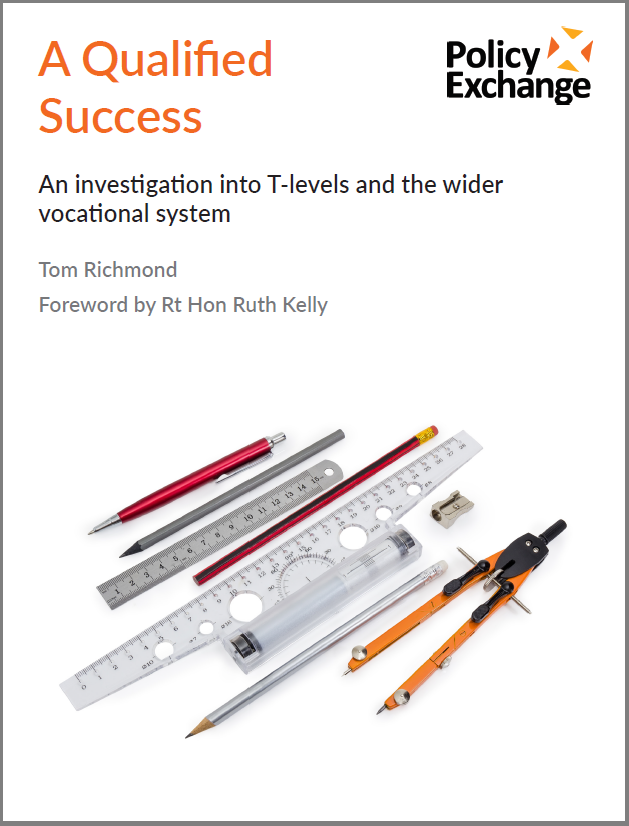
A QUALIFIED SUCCESS
FEBRUARY 2019
The education sector and Government must learn from the mistakes of the past if T-Levels are to be a success. This report warns that if this doesn’t happen, T-levels could fall into the same traps as previous technical qualifications such as GNVQs in the 1990s and Diplomas in the 2000s.
T-levels – two-year courses that aim to give students a technical alternative to A-levels at the age of 16 – are due to start being introduced in September 2020. But the report raises concerns about their implementation, including on:
Timing: the evidence suggests that the timetable for introducing T-levels is too brisk. It leaves insufficient time for any delays or alterations to the existing plans, particularly when procuring, designing and approving the new qualifications.
Lack of visibility: the evidence thus far shows that employers and parents are largely unaware of T-levels.
Insufficient clarity for stakeholders over their purpose or links to other pathways: after the 2016 Sainsbury Review criticised Diplomas for not appreciating that the two routes for technical education (classroom and workplace) need to be viewed as ‘two sides of the same coin’, the same problem seems to have emerged with T-levels.
Significant overlap with other qualifications: the lack of clarity over the purpose and role of T-levels inevitably blurs the lines between the different qualifications.
Overly-ambitious goals: the 2016 Sainsbury Review’s ambition of ‘bridging provision’ to help students move from T-levels to academic courses (and vice versa) is hard to quantify and it is likely to be several months, possibly years, before this concept can even be tested, let alone realised.
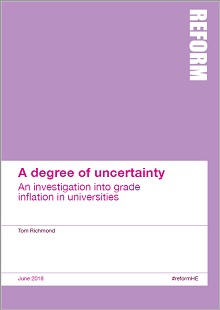
A DEGREE OF UNCERTAINTY
JUNE 2018
“We are once again experiencing the ‘winds of change’ in the university sector” said Universities Minister Sam Gyimah in February this year, noting that “not a single week goes by without a university story being splashed on the front pages”. Media coverage of rising student debt, Vice-Chancellor remuneration packages, strikes over pensions and debates around freedom of speech have all captured the attention of politicians and the general public. That said, accusations of ‘grade inflation’ in Higher Education (HE) is perhaps the most concerning development because it directly relates to the quality of degree courses in this country.
In the mid-1990s there was no detectable grade inflation at all, with 7 per cent of students awarded a First-class honours (‘First’), yet the upward trend in Firsts over the last two decades has been unrelenting. From 1997 to 2009 the proportion of Firsts almost doubled from 7 to 13 per cent, and in just seven years since 2010 the proportion of Firsts has doubled again from 13 to 26 per cent (climbing from 22 to 26 per cent in the last year alone). 54 institutions have seen their proportion of Firsts double or triple since 2010 and there are now 40 institutions (a quarter of all HE providers) that award Firsts to at least 30 per cent of their students.
The obvious question is what could be causing such a dramatic rise in degree grades? There is considerable evidence to suggest that ‘degree algorithms’ (which translate the marks achieved by students during their degree into a final classification) are contributing to grade inflation. Approximately half of universities have changed their degree algorithms in the last five years “to ensure that they do not disadvantage students in comparison with those in similar institutions”. Research has also identified serious concerns about how these algorithms treat ‘borderline’ cases where a student’s overall mark is close to the boundary of a better degree classification. One expert concluded that “universities are essentially massaging the figures, they are changing the algorithms and putting borderline candidates north of the border”.
Similarly, the pressure being placed on academics by senior managers at universities to lower their standards is also strongly implicated in grade inflation. Some academics have chosen to express their concerns publicly, even though this has on occasion put their own career at risk. One cited the “intolerable pressures on academic staff to pass students who should rightfully fail and to award higher classes of degrees to the undeserving”, while another complained that they had routinely awarded essays low grades “but have been brought under pressure, internally and externally, to provide higher grades.” The sheer volume of similar reports, documented over many years, is concerning and its potential impact on grade inflation is obvious enough.
Regrettably, two decades of uninterrupted grade inflation has resulted in degree grades becoming meaningless. What’s more, existing quality assurance mechanisms such as the Quality Assurance Agency (QAA) and the system of ‘external examiners’ are clearly unable to prevent any inflation. More recent innovations such as the ‘Teaching Excellence Framework’ and the new HE regulator – the Office for Students – are unlikely to fare any better. It is reasonable to assume that leaving the responsibility for ending grade inflation with universities will not have the desired effect. In a world of league tables, competition for students and high tuition fees, HE providers have no obvious incentive to reduce or reverse the seemingly relentless rise in top degree outcomes. A new approach is therefore needed.
This new report recommends that final-year students should sit a new, national assessment for each degree course. The assessments would be designed by professional bodies for degrees such as medicine and law and by learned societies for degrees in the humanities. The results of that assessment would determine the proportions of each degree grade that universities can award in each subject, rather than universities making their own decisions. At the same time, the proportion of Firsts awarded at a national level for each subject would be capped at 10 per cent in order to bring grade inflation to an end.
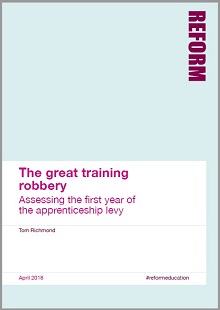
THE GREAT TRAINING ROBBERY
APRIL 2018
Now that the apprenticeship levy has completed its first full year of operation, this report reviews the available evidence to determine whether the levy will, as the Government hopes, “incentivise more employers to provide quality apprenticeships” and “transform the lives of young people who secure them”.
In the six months after the levy was introduced (April – October 2017), the number of people starting an apprenticeship fell by 40 per cent compared to the same period in the previous year. A similar downward trend was also evident across November and December. In addition, more experienced and older workers are increasingly becoming the focus of the apprenticeship programme, at the expense of less experienced and younger employees. Alongside the levy, the Conservative Party remains committed to its 2015 manifesto pledge that 3 million people will start an apprenticeship by 2020. Commentators have consistently raised concerns over this target as it prioritises the quantity of apprenticeships rather than their quality.
The introduction of the levy has also diminished the quality of apprenticeships. The list of roles now officially counted as an ‘apprenticeship’ includes many low-skill and often very short training courses. These roles include serving customers in a delicatessen or coffee shop, working on a hotel reception desk, performing basic office administration and serving food and drink in a restaurant. Such training courses do not meet the historical or international definition of an apprenticeship because they typically offer minimal training, represent low-wage jobs and do not constitute skilled occupations.
Moreover, employers are using the levy to rebadge existing training courses as apprenticeships to shift the costs of training onto the Government instead. The most obvious examples of this relabelling are found in leadership and management skills. The list of the most popular apprenticeship standards includes becoming a ‘Team Leader’, ‘Supervisor’ or ‘Manager’. Cranfield University’s prestigious School of Management has even re-designated its existing Executive MBA as an apprenticeship to attract up to a 90 per cent government subsidy towards the programme costs.
Almost 40 per cent of the ‘apprenticeship standards’ approved by the Government since 2012 fail to reach the international or historical definition of an apprenticeship. These mislabelled courses are consuming over 20 per cent of the funding available for newly-designed apprenticeships. Without reform, in 2019-20 the Government will spend £600 million on courses incorrectly labelled as apprenticeships.
Employers have become increasingly critical towards the levy, primarily due to the burdens associated with accessing the levy funds as well as identifying and selecting training and assessment providers. The substantial increase in bureaucracy, plus several other issues, has led business groups to brand the levy ‘disastrous’, ‘confusing’ and ‘broken’. Furthermore, the Register of Apprenticeship Training Providers has been beset by difficulties and the Register of Assessment Organisations has also struggled to command the respect of stakeholders, with serious concerns being raised about its approach to quality assurance.
The opening page of the Government-sponsored Richard Review, published in 2012, observed that the growth in apprenticeship numbers in the preceding years had “led us to stretch the definition of what an apprenticeship is too far and, as a consequence, we risk losing sight of the core features of what makes apprenticeships work, what makes them unique.” Six years on, there is a real danger that the same mistakes could be made all over again. At present, the levy is too complicated for employers, focused on too many inappropriate forms of training and as a result is unlikely to deliver value-for-money. If the necessary changes described in this report are made then apprentices, taxpayers and employers across the country stand to benefit for many years to come.
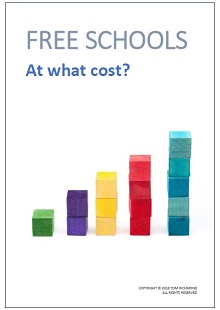
FREE SCHOOLS – AT WHAT COST?
JANUARY 2018
The world of education has never been short of initiatives and fads, some of which added value whereas many do not. While the number of Free Schools remains relatively small compared to the total stock of local maintained schools across England, the considerable political and financial investment that they have received will inevitably draw attention from many quarters.
The most up-to-date evidence shows that we cannot yet determine with confidence whether Free Schools have indeed raised educational standards. On that basis, it does not seem prudent to claim that they are the most successful education policy in the modern era, let alone the entire post-war period. The policy itself is also open to change, with Justine Greening announcing in one of her last acts as Education Secretary that Free Schools would be focused on more “challenging areas” in 2018. Such changes could make it more problematic to track the effect of Free Schools on school standards over time. Furthermore, even if Free Schools do indeed succeed in driving up standards, there is then a further question of whether any benefits that we may eventually see can reasonably justify the money spent on achieving said benefits.
This paper calculates that over £3.6 billion has been spent on Free Schools thus far. Supporters may choose to label this as money well spent, whereas critics are likely to claim it is precious money wasted (particularly in a climate of financial austerity). This paper does not aim to settle the debate over the value-for-money of Free Schools, rather to provide an additional lens through which to view the costs and benefits of the programme both now and in future. Supporters and critics will no doubt continue to cherry-pick individual case studies of Free Schools that confirm their respective points of view. What would be more useful for all sides of the debate is to continue monitoring the examination results and Ofsted ratings of Free Schools in the coming years as well as providing an on-going analysis of the overall programme expenditure. By doing this, we may finally be able to answer the question of whether the Free Schools programme as a whole has led to a tangible improvement in the lives of pupils and parents across the country.
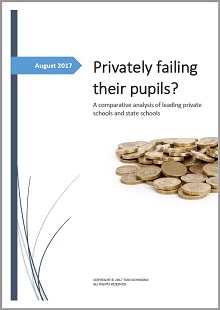
PRIVATELY FAILING THEIR PUPILS?
AUGUST 2017
An aura of rigour and quality has surrounded private schools for many years. This has subsequently become embedded in the minds of parents, politicians, pupils and no doubt many others. When the state sector is deemed to require additional support, it is the private sector that politicians turn to for their supposed expertise and knowledge. In light of this, it seems prudent to ask whether private schools deserve their reputation for high-quality teaching. Seeing as the chair of the Independent Schools Council declared last year that “parents should be more interested in the exam value-added score – a truer measure of the impact of teaching”, this paper has taken his advice and used the Government’s value-added data to analyse the impact of teaching in the leading private schools and state schools.
This new analysis shows that, while some private schools do a good job of educating children and young people, many do not. Given the Government’s commitment to forcing the private sector to become more involved in assisting state schools, it is somewhat alarming that the top state comprehensives seem to be delivering a better standard of education than the top private schools for a fraction of the cost. When the veil of impressive examination results and league table dominance of private schools is lifted, what you find underneath is an independent sector that contains a substantial number of poorly-performing institutions – including some schools that produce large numbers of top grades at A-level. For these schools to continue charging parents as much as £30,000 a year when the best data available shows that their progress scores place them in the bottom half of schools nationally is verging on scandalous.
It is hoped that the scrutiny provided by this paper shines a much-needed light on the performance of private schools, and in doing so prompts a serious discussion about whether state schools have anything to learn about high-quality teaching and learning from the independent sector.
TES AND FE WEEK
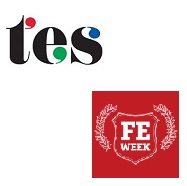
MAY 2017 – ‘Is the new Institute for Apprenticeships doomed?’ (£)
JUNE 2017 – ‘Did Gove ruin Greening’s shot at greatness?’ (£)
JULY 2017 – ‘20% off-the-job training should be the minimum for apprentices’
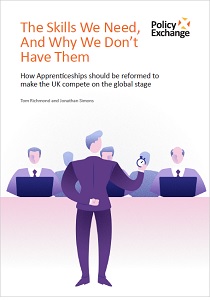
THE SKILLS WE NEED, AND WHY WE DON’T HAVE THEM
NOVEMBER 2016
Apprenticeships have enormous potential. In terms of brand awareness amongst employers and would-be apprentices, they offer the best route for delivering high quality technical education. But the concern is that not enough of the new apprenticeship standards will deliver the quality that is needed. This report concludes that it is time to put the Government’s apprenticeship reforms on a new path that gives the programme stronger foundations and a better educational and economic rationale as part of a more coherent vision for what our apprenticeship system could and should deliver for apprentices, employers and taxpayers across the country. In particular, this report details a series of recommendations across three main themes:
– Set a clear goal for the apprenticeship programme based on international best practice – and which is not about number of apprenticeships taken up
– Redefine all existing and upcoming apprenticeship standards to focus unequivocally on quality
– Design a delivery infrastructure and funding model that supports apprenticeships and wider high quality technical education qualifications
It is easy to see how the current approach, if not unchecked, risks leaving apprenticeships by 2020 in the same position as Train to Gain a decade earlier; a programme consumed with numbers, that lost sight of quality, that sought to bring in all forms of training within its orbit, and did not consistently deliver the transformative outcomes which were required. A skills system in a country that works for everyone, not just a privileged few, has the potential to do so much better. This report sets out how this can be done.
TES MAGAZINE

JANUARY 2016 – ‘Could Ofsted be facing the final curtain?’
APRIL 2016 – ‘Labour’s education policies were startlingly prophetic’
MAY 2016 – ‘To franchise exams or not to franchise exams?’ (£)
JULY 2016 – ‘Will new GCSE grades be popular? The odds are 9-1’
AUGUST 2016 – ‘The case against grammar schools’ (£)
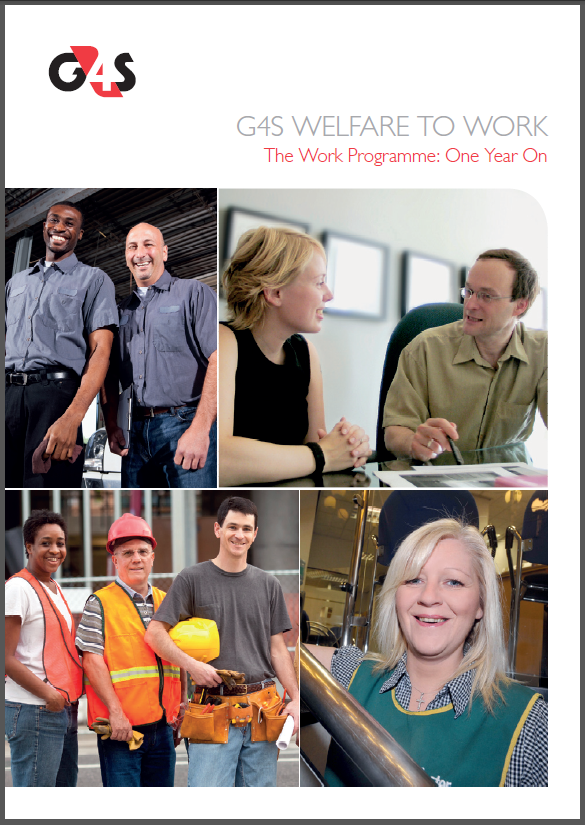
G4S WELFARE TO WORK – ANNUAL REVIEW
AUGUST 2012
This ‘annual review’ contains a wide range of information about how G4S Welfare to Work supports jobseekers in the South East, Yorkshire and Humber and the North West through the Work Programme – the Government’s flagship scheme for helping long-term unemployed people into employment. The review includes case studies of the jobseekers that G4S helped into sustainable employment, the results of their supply chain survey, examples of G4S’s work with local and national employers and feedback from key stakeholders in their three contract areas.
Here are some of the key achievements over the first 12 months of the G4S Work Programme from June 2011 to June 2012:
– G4S and their supply chain worked together to help over 9,000 people into employment, with 82% sustaining that employment
– G4S invested £3.6 million in voluntary sector partners throughout their supply chain
– The work of G4S generated an estimated annualised saving of £54 million to the taxpayer through helping people off into work
– G4S supported over 5,000 employers across three contract areas to take on a jobseeker through the Work Programme

PAYMENT BY RESULTS – WHAT CAN WE LEARN FROM THE WORK PROGRAMME?
JUNE 2011
The ‘Work Programme’ represents the most significant shift in the welfare-to-work industry for many years. One of the most innovative features of the Work Programme is its emphasis on ‘payment by results’, which means that providers only get paid once an outcome has been achieved. In the case of the Work Programme, an outcome is helping someone secure employment. This policy paper looks in detail at the challenges faced in designing the funding model for the Work Programme. These challenges include: how the Government should fund ‘payment by results’; choosing how many providers the Government needs, and whether should they be from the private, public or voluntary sector; ensuring that providers deliver a high-quality service; and deciding when providers should be paid for delivering services.
The policy paper goes on to discuss how the funding model for the Work Programme could be applied to two other policy areas that will soon incorporate ‘payment by results’: offender rehabilitation and college courses. The same issues can also be considered by ministers and government officials when assessing other potential opportunities for a more outcome-based funding system such as the NHS.
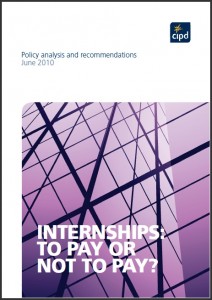
INTERNSHIPS: TO PAY OR NOT TO PAY?
JUNE 2010
With youth unemployment at record levels and graduates struggling to find work, internships – typically a period of workplace learning for undergraduates and graduates lasting from 3 to 12 months – have become an increasingly high-profile option for those finishing their university and college courses. The benefits to young people of completing an internship can be considerable in terms of learning technical or practical skills, gaining experience in an industry sector and developing their employability skills such as teamwork. In addition, employers who run internships stand to gain through bringing young people with new ideas into their organisation and building a talent pipeline for their industry, while some employers are even using internships as a way of assessing potential new recruits. However, despite these significant benefits to young people and employers, the debate over whether internships should be paid or unpaid has yet to be resolved.
This policy paper made three recommendations:
1. The existing apprenticeship minimum wage structure should be converted into a new ‘training wage’ of £2.50 an hour, which applies to all apprenticeships and internships.
2. Through guaranteeing that all interns are paid a minimum of £2.50 an hour, all unpaid internship positions should subsequently be treated as a breach of National Minimum Wage legislation.
3. To accompany the new training wage, a code of best practice for internships should be published to deliver as many high-quality opportunities for young people as possible.
GRADUATE UNEMPLOYMENT
MARCH 2010
Financial Times – Call for review of 50% university target (subscription required)
Daily Telegraph – Most graduates not in jobs linked to their degree
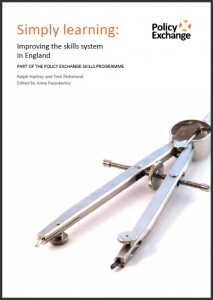
SIMPLY LEARNING
IMPROVING THE SKILLS SYSTEM IN ENGLAND
JANUARY 2010
The world of skills, whether it be vocational education, apprenticeships or adult education, has been subject to near constant upheaval for at least 25 years. In recent years the Government has attempted to increase the volume of post compulsory education, improve the status of vocational courses and make the whole system more ‘demand-led’. Yet the skills system in England remains chaotic and unproductive. It is widely agreed that not only is not demand-led, being driven instead by the priorities of the Government, but it is also shockingly complex and wasteful. The purpose of this report was to unpick the problems which beset the skills system in England. We offered recommendations for reform which will simplify the system and make it genuinely responsive to the needs of employers and individuals, whilst incentivising providers to deliver to the hardest to reach learners. As part of this analysis the report looked in detail at Train to Gain, the Government’s funding scheme for employers; apprenticeships; Sector Skills Councils, basic skills; Skills Accounts; and the hardest to reach learners.
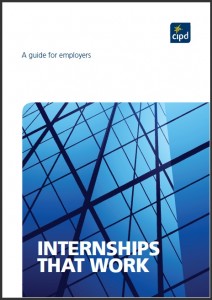
INTERNSHIPS THAT WORK
A GUIDE FOR EMPLOYERS
DECEMBER 2009
This guide was aimed at employers that are either thinking of starting an internship programme for the first time or wish to improve their current offering. The guide covers six principles of internships:
RECRUITMENT;
PAYMENT AND DURATION;
INDUCTION;
TREATMENT;
SUPERVISION;
REFERENCE AND FEEDBACK.
Each of these principles is given a dedicated section within this guide and goes on to suggest how they can be addressed in a way that gives the greatest benefit to both the intern and the employer. At the back of the guide, you will also find a checklist for employers to use when assessing the quality of their internship programme and a voluntary written agreement that gives employers the option of formally recognising their commitment to the principles in this guide.
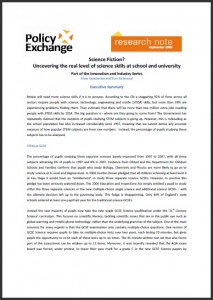
SCIENCE FICTION?
UNCOVERING THE REAL LEVEL OF SCIENCE SKILLS AT SCHOOL AND UNIVERSITY
SEPTEMBER 2009
Britain will need more science skills if it is to prosper. According to the CBI a staggering 92% of firms across all sectors require people with science, technology, engineering and maths (STEM) skills, but more than 59% are experiencing problems finding them. The Government has repeatedly claimed that the numbers of pupils studying STEM subjects is going up. However, this is misleading as the school population has also increased considerably since 1997, meaning that we cannot derive any accurate measure of how popular STEM subjects are from raw numbers. Our report debunked the Government’s claims about the performance and take-up of science subjects at every level – GCSE, A Level and degree. Instead, misleading figures and lowered standards were found to behind many of the apparent ‘improvements’, with the result that British businesses now face a critical skills shortage.
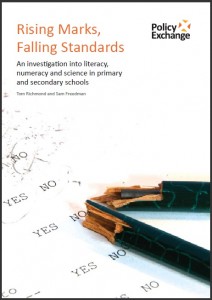
RISING MARKS, FALLING STANDARDS
AN INVESTIGATION INTO LITERACY, NUMERACY AND SCIENCE IN PRIMARY AND SECONDARY SCHOOLS
APRIL 2009
One of the most enduring debates in education concerns ‘standards’ in primary and secondary schools. Literacy, numeracy and science form the backbone of the school curriculum with the intention of equipping pupils with these core skills by the time they leave school. The purpose of this report is to investigate the extent to which literacy, numeracy and science have improved since 1997 with a particular focus on SATs at age 7, 11 and 14. Through a detailed analysis of national school performance data, a number of serious concerns are raised with regard to the current state of pupils’ core skills. In addition, the curriculum from the ages of 14 to 16 – which includes GCSEs, Diplomas and Apprenticeships – is assessed in terms of its rigour, complexity and credibility. We also put forward our recommendations for the future direction of primary and secondary education, including a new model for SATs, more freedom for schools in how they teach core skills and creating a better set of academic and vocational options for pupils at age 14.
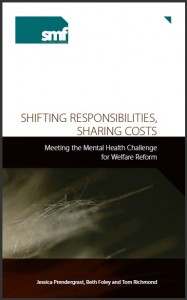
SHIFTING REPONSIBILITIES, SHARING COSTS
MEETING THE MENTAL HEALTH CHALLENGE FOR WELFARE REFORM
OCTOBER 2008
With a long way to go to meet the government target of one million fewer claimants on Incapacity Benefit by 2015, there is an increasing recognition that efforts must focus not only on returning people from welfare to work, but also on preventing the slide from employment towards benefits in the first place. Intertwined with this challenge is the prevalence of mental ill health in the UK population and workforce, with as many as one in six employees suffering from some form of common mental illness – such as stress, anxiety or depression – at any one time. Mental ill health presents significant costs for individuals, employers and the state, but although all these stakeholders would benefit from the provision of effective and timely interventions to support those with common mental health conditions, diluted responsibilities mean there is a market failure in the provision of appropriate products and services.
This study explored the significance of mental ill health for UK businesses and society, the benefits of remaining in employment for those with mental health conditions and the barriers to doing so. It argued that employers should be encouraged to take on responsibility for the provision of appropriate support and advocated a range of mechanisms which the government should explore to offer effective incentives.
